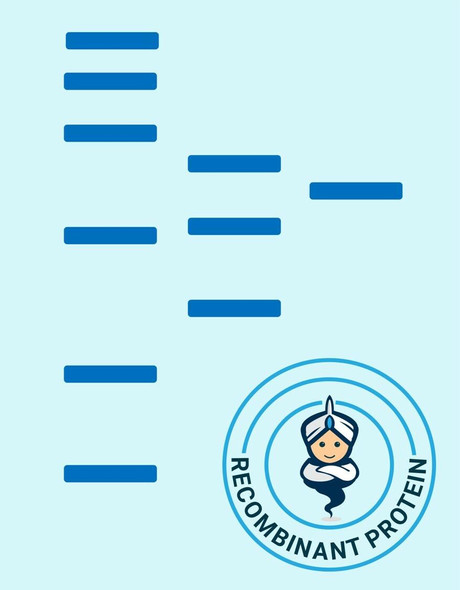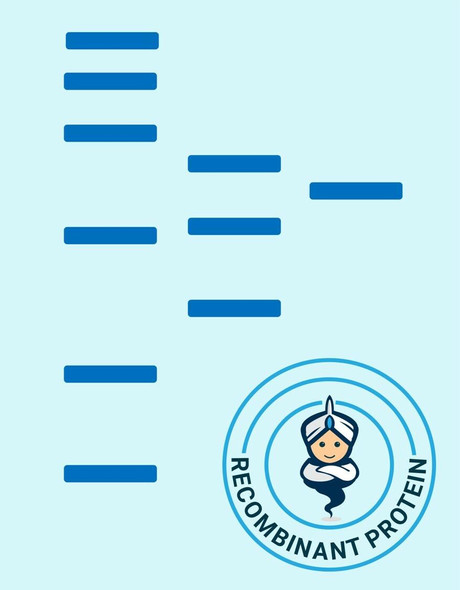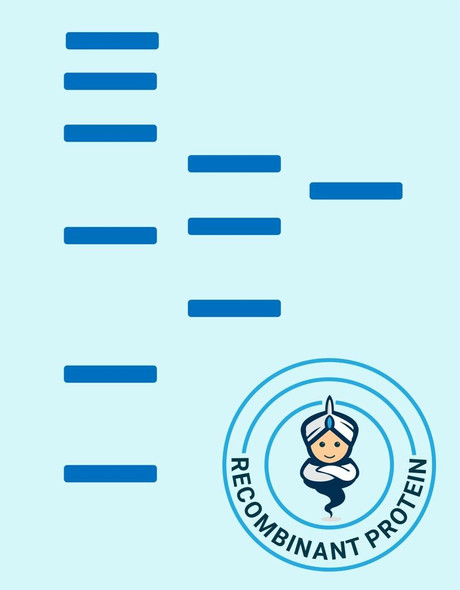Description
| Product Name: | Mouse CST3 Recombinant Protein |
| Product Code: | RPPB3283 |
| Size: | 10µg |
| Species: | Mouse |
| Target: | CST3 |
| Synonyms: | Post G-globulin, CST 3, CST3, Gamma-Trace, Cystatin 3, Amyloid Angiopathy and Cerebral Hemorrhage, Cystatin-C precursor, neuroendocrine basic polypeptide. |
| Source: | Escherichia Coli |
| Physical Appearance: | Sterile Filtered White lyophilized (freeze-dried) powder. |
| Formulation: | The sterile filtered concentrated (0.5mg/ml) protein solution was lyophilized with 20mM Tris & 50mM NaCl pH-7.5. |
| Solubility: | Add 0.1M Acetate buffer pH 4 to a working concentration of 0.5mg/ml and let the lyophilized pellet dissolve completely. |
| Stability: | Store lyophilized protein at -20°C. Aliquot the product after reconstitution to avoid repeated freezing/thawing cycles. Reconstituted protein can be stored at 4°C for a limited period of time. |
| Purity: | Greater than 95% as determined by SDS-PAGE. |
| Amino Acid Sequence: | MRGSHHHHHH GMASATPKQG PRMLGAPEEA DANEEGVRRA LDFAVSEYNK GSNDAYHSRA IQVVRARKQL VAGVNYFLDV EMGRTTCTKS QTNLTDCPFH DQPHLMRKAL CSFQIYSVPW KGTHSLTKFSCKNA |
Cystatins are a superfamily of cysteine proteinase inhibitors found in both plants and animals. They comprise a group of proteinase inhibitors, widely distributed in tissues and body fluids, and form tight complexes with cysteine proteases such as cathepsin B, H, L and S. Cystatin C, a secreted molecule of this family, is of interest from biochemical, medicine and evolutionary points of view. Cystatin C, with molecular weight of 13260 Da, is composed of 120 amino acids, lacks carbohydrate and has two disulfide bridges located near the carboxyl terminus. Cystatin C is increased in patients with malignant diseases, and is related to the insufficiency of renal function and appears to be a better marker than creatinine. On the other hand, low levels of cystatin C involve cause the breakdown of the elastic laminae and, subsequently, the atherosclerosis and abdominal aortic aneurysm.
Cystatin-C Murine Recombinant produced in E.Coli is a single, non-glycosylated, polypeptide chain containing 134 amino acids and having a molecular mass of 15kDa. The Mouse Cystatin-C is fused to His tag at N-Terminus.The Mouse Cystatin-C is purified by proprietary chromatographic techniques.
| UniProt Protein Function: | CST3: As an inhibitor of cysteine proteinases, this protein is thought to serve an important physiological role as a local regulator of this enzyme activity. Defects in CST3 are the cause of amyloidosis type 6 (AMYL6); also known as hereditary cerebral hemorrhage with amyloidosis (HCHWA), cerebral amyloid angiopathy (CAA) or cerebroarterial amyloidosis Icelandic type. AMYL6 is a hereditary generalized amyloidosis due to cystatin C amyloid deposition. Cystatin C amyloid accumulates in the walls of arteries, arterioles, and sometimes capillaries and veins of the brain, and in various organs including lymphoid tissue, spleen, salivary glands, and seminal vesicles. Amyloid deposition in the cerebral vessels results in cerebral amyloid angiopathy, cerebral hemorrhage and premature stroke. Cystatin C levels in the cerebrospinal fluid are abnormally low. Genetic variations in CST3 are associated with age- related macular degeneration type 11 (ARMD11). ARMD is a multifactorial eye disease and the most common cause of irreversible vision loss in the developed world. In most patients, the disease is manifest as ophthalmoscopically visible yellowish accumulations of protein and lipid that lie beneath the retinal pigment epithelium and within an elastin-containing structure known as Bruch membrane. Belongs to the cystatin family. |
| UniProt Protein Details: | Protein type:Secreted, signal peptide; Secreted; Inhibitor Cellular Component: axon; basement membrane; cell projection; cell soma; contractile fiber; cytoplasm; endoplasmic reticulum; extracellular region; extracellular space; lysosome; multivesicular body; nuclear membrane; perinuclear region of cytoplasm; vesicle Molecular Function:beta-amyloid binding; cysteine protease inhibitor activity; endopeptidase inhibitor activity; identical protein binding; protease binding; protease inhibitor activity Biological Process: defense response; fibril organization and biogenesis; negative regulation of peptidase activity; negative regulation of proteolysis; positive regulation of cell proliferation; positive regulation of DNA replication; regulation of programmed cell death; response to oxidative stress |
| NCBI Summary: | The protein encoded by this gene is a cysteine protease inhibitor involved in neurodegenerative and cardiovascular processes. The encoded protein inhibits aggregation of beta-amyloid protein, a hallmark of Alzheimer's disease, so it may be useful as a therapeutic. This protein also may be a biomarker for atherosclerosis. [provided by RefSeq, Aug 2015] |
| UniProt Code: | P21460 |
| NCBI GenInfo Identifier: | 1345935 |
| NCBI Gene ID: | 13010 |
| NCBI Accession: | P21460.2 |
| UniProt Secondary Accession: | P21460,Q544Y0, |
| UniProt Related Accession: | P21460 |
| Molecular Weight: | 15,531 Da |
| NCBI Full Name: | Cystatin-C |
| NCBI Synonym Full Names: | cystatin C |
| NCBI Official Symbol: | Cst3�� |
| NCBI Official Synonym Symbols: | CysC�� |
| NCBI Protein Information: | cystatin-C |
| UniProt Protein Name: | Cystatin-C |
| UniProt Synonym Protein Names: | Cystatin-3 |
| Protein Family: | Cystatin |
| UniProt Gene Name: | Cst3�� |
| UniProt Entry Name: | CYTC_MOUSE |










